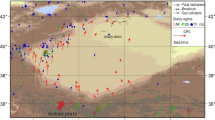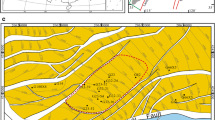Abstract
Present in situ stress field is the basis of petroleum engineering, and its distribution characteristics are the key to reservoir reconstruction. The target reservoir in SH Oilfield is a fractured-vuggy reservoir controlled by strike-slip fault, which needs fracturing. However, the present in situ stress field distribution characteristics of the main faults in SH Oilfield are still unclear, which needs to be solved. Taking SB1, SB5, and SB7 faults as research targets, the magnitude and direction of present in situ stress field in the study area are calculated by using logging data and oil well dynamic data. The single well in situ stress profile is established, and then the difference of present in situ stress distribution in different strain segments of strike-slip fault is discussed. On this basis, the boundary element numerical simulation method is used to study the influence of the fault on the present in situ stress distribution. The trend of fracture sliding friction is introduced to measure reservoir quality qualitatively. The results show that the maximum principal stress in SH area is 180~1220MPa, and the direction is NE39 °~ 46°; the middle principal stress is 178~187MPa, and the direction is vertical; the minimum principal stress is 131~135MPa, and the direction is SE129°~136°. The whole SH area is in the state of strike-slip stress. The strike-slip fault disturbs the direction of the horizontal principal stress. The maximum horizontal principal stress near the fault twists obviously and tends to be parallel to the fault. The present in situ stress field state of different strain segments in strike-slip fault is different, and the difference is mainly reflected in the maximum horizontal principal stress. The horizontal compression of uplift segment is the strongest, up to 227MPa, followed by the translation segment, and the horizontal compression of pull-apart segment is obviously weakened, only 197MPa. Using the fracture sliding trend as the qualitative evaluation standard of reservoir quality, it is found that the permeability of pull-apart segment has the best permeability, the translation segment takes the second place, and the uplift section is the worst. The results are consistent with the actual oil production.




















Similar content being viewed by others
References
Alsop I (2009) Tectonics of strike-slip restraining and releasing bends. Geol Mag 146(5):781–782. https://doi.org/10.1017/S0016756809006025
Anderson EM (1951) The dynamic of faulting, 2nd edn. Oliver and Boyd, London, p 206. https://doi.org/10.1144/transed.8.3.387
Bouatia M, Demagh R, Derriche Z (2020) Structural behavior of pipelines buried in expansive soils under rainfall infiltration (Part I: Transverse Behavior). Civil Engineering Journal 6(9):1822–1838. https://doi.org/10.28991/cej-2020-03091585
Byerlee J, Mjachkin V, Summers R, et al (1978) Structures developed in fault gouge during stable sliding and strike-slip. Tectonophysics 44(1–4):161–171. https://doi.org/10.1016/0040-1951(78)90068-9
Caine JS, Evans JP, Forster CB (1996) Fault zone architecture and permeability structure. Geology 24:1025–1028. https://doi.org/10.1130/0091-7613(1996)0242.3.CO
Chen S, Xiao M, Chen J et al (2020) Disturbance law of faults to in-situ stress field directions and its inversion analysis method. Chinese Journal of Rock Mechanics and Engineering, 2020 39(07):1434–1444 (in Chinese)
Colmenares LB, Zoback MD (2002) A statistical evaluation of intact rock failure criteria constrained by polyaxial test data for five different rocks. Int J Rock Mech Min Sci 39(6):695–729. https://doi.org/10.1016/s1365-1609(02)00048-5
De Joussineau G, Aydin A (2007) The evolution of the damage zone with fault growth and its multiscale characterization. J Geophys Res Solid Earth 112:B12401. https://doi.org/10.1029/2006JB004711
De Joussineau G, Aydin A (2009) Segmentation along strike-slip faults revisited. Pure Appl Geophys 166(10-11):1575–1594. https://doi.org/10.1007/s00024-009-0511-4
Deng S, Li H, Zhang Z et al (2018) Characteristics of differential activities in major strike-slip fault zones and their control on hydrocarbon enrichment in Shunbei area and its surroundings. Tarim Basin, Oil and Gas Geology 39(5):38–48. https://doi.org/10.11743/ogg20180503
Deng S, Li H, Zhang Z et al (2019) Structural characterization of intracratonic strike-slip faults in the central Tarim Basin. AAPG Bull 103(1):109–137. https://doi.org/10.1306/06071817354
Ding W, Zeng W, Wang R et al (2016) Method and application of tectonic stress field simulation and fracture distribution prediction in shale reservoir. Geosci Front 023(002):63–74 (in Chinese)
Ferrill DA, Morris AP, Hennings PH, et al (2014) Faulting and fracturing in shale and self-sourced reservoirs: Introduction. AAPG Bulletin 98(11):2161–2164. https://doi.org/10.1306/intro073014
Finzi Y, Hearn EH, Ben-Zion Y et al (2009) Structural properties and deformation patterns of evolving strike-slip faults: numerical simulations incorporating damage rheology. Pure Appl Geophys. https://doi.org/10.1007/s00024-009-0522-1
Flodin EA, Aydin A (2004) Evolution of a strike-slip fault network, valley of fire state park, southern Nevada. Geol Soc Am Bull 116(1-2):42–59. https://doi.org/10.1130/B25282.1
Ghalayini R, Daniel JM, Homberg C et al (2014) Impact of Cenozoic strike-slip tectonics on the evolution of the northern Levant Basin (offshore Lebanon). Tectonics 33(11):1–22. https://doi.org/10.1002/2014TC003574
He D, Zhou X, Yang H et al (2008) Formation mechanism and tectonic types of intracratonic paleo-uplifts in the Tarim Basin. Earth Science Frontiers 15(2):207–221 (in Chinese)
Heidbach O, Rajabi M, Ziegler M, et al (2016) The World Stress Map Database Release - Global Crustal Stress Pattern vs. Absolute Plate Motion EGU General Assembly
Hopkins CW (1997) The importance of in-situ-stress profiles in hydraulic-fracturing applications. J Pet Technol 49(9):944–948. https://doi.org/10.2118/38458-MS
Husodon JA, Cooling CM (1988) In situ rock stresses and their measurement in U.K.—Part I. The current state of knowledge, International Journal of Rock Mechanics and Mining Sciences and Geomechanics Abstracts 25(6):363–370. https://doi.org/10.1016/0148-9062(88)90976-X
Jiao F (2017) Significance of oil and gas exploration in NE strike-slip fault belts in Shuntuoguole area of Tarim basin. Oil Gas Geol 38(5):831–839 (in Chinese)
Jourde H, Flodin EA, Aydin A, Durlofsky LJ et al (2002) Computing permeability of fault zones in Eolian sandstone from outcrop measurements. AAPG Bull 86:1187–1200. https://doi.org/10.1306/61EEDC4C-173E-11D7-8645000102C1865D
Kang SS, Kim JM, Kaneko K et al (2010) Clarification of regional and local in situ stresses using the compact conical-ended borehole overcoring technique and numerical analysis. Island Arc 12(3):247–255. https://doi.org/10.1046/j.1440-1738.2003.00380.x
Kocyigit A (2013) New field and seismic data about the intraplate strike-slip deformation in Van region, East Anatolian plateau. J Asian Earth Sci 62:586–605. https://doi.org/10.1016/j.jseaes.2012.11.008
Li M, Tang L, Qi L et al (2015) Differential tectonic evolution and its controlling on hydrocarbon accumulation in the south slope of Tabei Uplift. Nat Gas Geosci 26(2):218–227 (in Chinese)
Lin W, Xiong S, Liu Y et al (2021) Spontaneous imbibition in tight porous media with different wettability: pore-scale simulation. Phys Fluids 33(3):032013. https://doi.org/10.1063/5.0042606
Liu Z, Lv X, Li Y et al (2016) Mechanism of faults acting on in-situ stress field direction. Oil Gas Geol 37(3):387–393 (in Chinese)
Lu X, Wang Y, Tian F et al (2017) New insights into the carbonate karstic fault system and reservoir formation in the Southern Tahe area of the Tarim Basin. Mar Pet Geol 86:587–605. https://doi.org/10.1016/j.marpetgeo.2017.06.023
Lyros E, Kostelecky J, Plicka V et al (2021) Detection of tectonic and crustal deformation using GNSS data processing: the case of "PPGnet" to the literature review. Civil Engineering Journal 7(1):14–23. https://doi.org/10.28991/cej-2021-03091633
Matsukik K, Nakama S, Sato T (2009) Estimation of regional stress by FEM for a heterogeneous rock mass with a large fault. Int J Rock Mech Min Sci 46(1):31–50. https://doi.org/10.1016/j.ijrmms.2008.03.005
Mcclay K, Bonora M (2001) Analog models of restraining stepovers in strike-slip fault systems. Am Assoc Pet Geol Bull 85(2):233–260. https://doi.org/10.1016/S0378-7753(00)00605-4
Monteiro G, Neves J, Gomes J (2020) Seismic monitoring system of Baixo Sabor and Feiticeiro Dams. Civil. Engineering Journal 6(11):2072–2085. https://doi.org/10.28991/cej-2020-03091603
Moos D, Zoback MD (1990) Utilization of observations of well bore failure to constrain the orientation and magnitude of crustal stresses: application to continental, Deep Sea Drilling Project, and Ocean Drilling Program boreholes. J Geophys Res Solid Earth 95(B6):9305. https://doi.org/10.1029/JB095iB06p09305
Morris A, Ferrill DA, Henderson DB (1996) Slip-tendency analysis and fault reactivation. Geology 24(3):275–278. https://doi.org/10.1130/0091-7613(1996)024<0275:STAAFR>2.3.CO;2
Mousavipour F, Riahi MA, Moghanloo HG (2020) Prediction of in situ stresses, mud window and overpressure zone using well logs in south pars field. J Pet Explor Prod Technol 10:3–4. https://doi.org/10.1007/s13202-020-00890-9
Myers R, Aydin A (2004) The evolution of faults formed by shearing across joint zones in sandstone. J Struct Geol 26(5):947–966. https://doi.org/10.1016/j.jsg.2003.07.008
Odling NE, Harris SD, Knipe RJ (2004) Permeability scaling properties of fault damage zones in siliclastic rocks. J Struct Geol 26(9):1727–1747. https://doi.org/10.1016/j.jsg.2004.02.005
Ramamurthy T (1993) Strength, modulus responses of anisotropic rocks. In: Hudson JA (ed) Compressive Rock Engineering, vol 1. Pergamon, Oxford, pp 313–329
Rasouli V, Pallikathekathil ZJ, Mawuli E (2011) The influence of perturbed stresses near faults on drilling strategy: a case study in blacktip field, north australia. J Pet Sci Eng 76(1-2):37–50. https://doi.org/10.1016/j.petrol.2010.12.003
Ru Z, Hu J, Madni AS et al (2020) A study on the optimal conditions for formation of complex fracture networks in fractured reservoirs. J Struct Geol 135:104039. https://doi.org/10.1016/j.jsg.2020.104039
Secor DT (1965) Role of fluid pressure in jointing. Am J Sci 263(8):633–646. https://doi.org/10.2475/ajs.263.8.633
Segall P, Pollard DD (1980) Mechanics of discontinuous faults. Jour.geophys.res 85:4337–4350. https://doi.org/10.1029/JB085iB08p04337
Song D, Li M, Wang TG (2013) Geochemical studies of the Silurian oil reservoir in the Well Shun-9 prospect area, Tarim basin, NW China. Pet Sci 10(4):432–441. https://doi.org/10.1007/s12182-013-0293-2
Stephansson O, Zang A (2012) ISRM suggested methods for rock stress estimation—part 5: establishing a model for the in-situ stress at a given site. Rock Mech Rock Eng 45(6):955–969. https://doi.org/10.1007/s00603-012-0270-x
Tang L, Huang T, Qiu H et al (2012) Saltrelated structure and deformation mechanism of the Middle-Lower Cambrian in the middle-west parts of the Central Uplift and adjacent areas of the Tarim Basin. Sci China Earth Sci 55:1123–1133. https://doi.org/10.1007/s11430-012-4414-3
Townend J, MD Zoback (2000) How faulting keeps the crust strong. Geology 28(5):399–402. https://doi.org/10.1130/0091-7613(2000)28<399:HFKTCS>2.0.CO;2
Wang C, Gao G, Yang S et al (2019) Analysis and prediction of stress fields of Sichuan— Tibet railway area based on contemporary tectonic stress field zoning in Western China. Chin J Rock Mech Eng 38(11):2242–2253 (in Chinese)
Wang Q, Ru Z, Zhao R et al (2020) A study on permeability along strike slip faults in Shunbei reservoir of Tarim Basin, China. Energy Sources Part A Recovery Utilization and Environmental Effects 1:1–17. https://doi.org/10.1080/15567036.2020.1841341
Woodcock NH, Rickards B (2003) Transpressive duplex and flower structure: dent fault system, NW England. J Struct Geol 25(12):1981–1992. https://doi.org/10.1016/S0191-8141(03)00057-9
Yamamoto K (2009) A theory of rock core-based methods for in-situ stress measurement. Earth Planets & Space 61(10):1143–1161. https://doi.org/10.1186/BF03352966
Yu J, Li Z, Yang L (2016) Fault system impact on paleokarst distribution in the Ordovician Yingshan Formation in the central Tarim basin, northwest China. Mar Pet Geol 71:105–118. https://doi.org/10.1016/j.marpetgeo.2015.12.016
Yin S, Ding W, Zhou W et al (2017) In situ stress field evaluation of deep marine tight sandstone oil reservoir: a case study of Silurian strata in northern Tazhong area, Tarim Basin, NW China. Mar Pet Geol 80:49–69. https://doi.org/10.1016/j.marpetgeo.2016.11.021
Zhao R, Zhao T, Li H et al (2019) Fault-controlled fracture-cavity reservoir characterization and main-controlling factors in the Shunbei hydrocarbon field of Tarim Basin. Special Oil & Gas Reservoirs 26(5):8–13 (in Chinese)
Zhou C, Yin J, Luo J et al (2012) Law of geo-stress distribution in the vicinity of fault zone. Journal of Yangze River Scientific Research Institute 29(7):57–61 (in Chinese)
Zoback LBCD (2002) A statistical evaluation of intact rock failure criteria constrained by polyaxial test data for five different rocks. Int J Rock Mech Min Sci. https://doi.org/10.1016/S1365-1609(02)00048-5
Zoback MD, Barton CA, Brudy M et al (2003) Determination of stress oritation and magnitude in deep wells. Int J Rock Mech Min Sci 40(7-8):1049–1076. https://doi.org/10.1016/j.ijrmms.2003.07.001
Acknowledgements
The authors would like to acknowledge the support provided by Project of Science and Technology Department of Sinopec “reservoir description and reserve classification evaluation of Shunbei fault solution reservoir” (P20064-1).
Author information
Authors and Affiliations
Corresponding author
Additional information
Responsible Editor: François Roure
Rights and permissions
About this article
Cite this article
Zhao, T., Hu, W., Zhao, R. et al. Present in-situ stress distribution characteristics of strike-slip in SH Oilfield, Tarim Basin. Arab J Geosci 14, 1223 (2021). https://doi.org/10.1007/s12517-021-07552-y
Received:
Accepted:
Published:
DOI: https://doi.org/10.1007/s12517-021-07552-y




